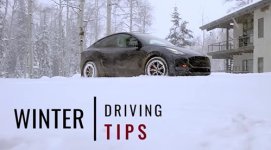Winter driving in the Tesla Model Y comes with unique considerations due to its electric drivetrain and features like regenerative braking. Here are top tips for winter driving and how to address regenerative braking issues:
Top 3 Winter Driving Tips for the Tesla Model Y
Precondition the Battery
Why: Preconditioning ensures optimal battery performance in cold weather, improving range and allowing for better regenerative braking.
How: Use the Tesla app to preheat the car and battery while plugged in. Navigate to a Supercharger or set a destination, and the car will automatically precondition the battery.

Optimize Traction Settings
Why: Snow, ice, or slushy roads can reduce traction, but the Model Y has features to manage this.
How: Enable Slip Start mode for better control when stuck in snow or ice. Ensure winter tires are installed for maximum grip.
Efficient Energy Management
Why: Cold weather can significantly reduce range.
How:
Use Range Mode to prioritize battery usage.
Limit cabin heating by using heated seats and steering wheel instead of blasting the heater.
Drive conservatively to preserve energy.
Regenerative Braking Issues in Winter
The Problem:
In extremely cold temperatures, regenerative braking can be reduced or temporarily unavailable. This occurs because the battery is too cold to accept energy from the regen system.
Solutions:
Preheat the Battery
Preconditioning helps warm up the battery, restoring regenerative braking functionality.
Monitor the Dash Indicators
Yellow or blue dashed lines on the energy bar indicate limited regenerative braking. Adjust driving expectations accordingly.
Use Blended Braking
When regen braking is reduced, be prepared to use traditional braking more often. Practice modulating the brake pedal for a smoother experience.
Additional Tips for Winter Driving in a Tesla Model Y:
Keep the Battery Charged: Maintain at least a 20-30% charge to prevent performance issues in cold weather.
Utilize Scheduled Departure: This feature ensures the car is warm and ready with an optimized battery before driving.
Check Tire Pressure Regularly: Cold weather decreases tire pressure, which can affect traction and range. Inflate tires to the recommended PSI.
Disable Automatic Wipers: Ice or snow can damage the wiper blades or the sensor; use manual controls if needed.
Youtube
Top 3 Winter Driving Tips for the Tesla Model Y
Precondition the Battery
Why: Preconditioning ensures optimal battery performance in cold weather, improving range and allowing for better regenerative braking.
How: Use the Tesla app to preheat the car and battery while plugged in. Navigate to a Supercharger or set a destination, and the car will automatically precondition the battery.

Optimize Traction Settings
Why: Snow, ice, or slushy roads can reduce traction, but the Model Y has features to manage this.
How: Enable Slip Start mode for better control when stuck in snow or ice. Ensure winter tires are installed for maximum grip.
Efficient Energy Management
Why: Cold weather can significantly reduce range.
How:
Use Range Mode to prioritize battery usage.
Limit cabin heating by using heated seats and steering wheel instead of blasting the heater.
Drive conservatively to preserve energy.
Regenerative Braking Issues in Winter
The Problem:
In extremely cold temperatures, regenerative braking can be reduced or temporarily unavailable. This occurs because the battery is too cold to accept energy from the regen system.
Solutions:
Preheat the Battery
Preconditioning helps warm up the battery, restoring regenerative braking functionality.
Monitor the Dash Indicators
Yellow or blue dashed lines on the energy bar indicate limited regenerative braking. Adjust driving expectations accordingly.
Use Blended Braking
When regen braking is reduced, be prepared to use traditional braking more often. Practice modulating the brake pedal for a smoother experience.
Additional Tips for Winter Driving in a Tesla Model Y:
Keep the Battery Charged: Maintain at least a 20-30% charge to prevent performance issues in cold weather.
Utilize Scheduled Departure: This feature ensures the car is warm and ready with an optimized battery before driving.
Check Tire Pressure Regularly: Cold weather decreases tire pressure, which can affect traction and range. Inflate tires to the recommended PSI.
Disable Automatic Wipers: Ice or snow can damage the wiper blades or the sensor; use manual controls if needed.
Youtube
